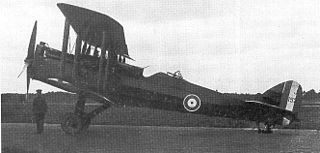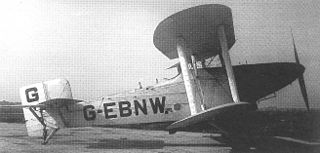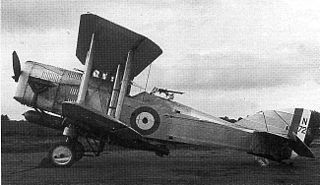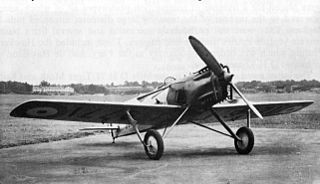
The Hawker Harrier was a British experimental biplane torpedo bomber aircraft built by Hawker Aircraft to a specification issued in the 1920s for the Royal Air Force.

The Hawker Tornado was a British single-seat fighter aircraft design of the Second World War for the Royal Air Force as a replacement for the Hawker Hurricane. The planned production of Tornados was cancelled after the engine it was designed to use, the Rolls-Royce Vulture, proved unreliable in service. A parallel airframe that used the Napier Sabre engine continued into production as the Hawker Typhoon.

The Avro 549 Aldershot was a British single-engined heavy bomber aircraft built by Avro.

The Gloster F.9/37, also known as the Gloster G.39, was a British twin-engined design from the Gloster Aircraft Company for a cannon-armed heavy fighter to serve with the Royal Air Force, planned before the Second World War. The F.9/37 was rejected in favour of other designs.

The de Havilland DH.14 Okapi was a British two-seat day bomber of the 1910s built by de Havilland. The aircraft was designed as an Airco DH.4 and DH.9 replacement, but it never entered production.

The Airco DH.10 Amiens was a twin-engined heavy bomber designed and produced by the British aircraft manufacturer Airco. It performed the first nighttime air mail service in the world on 14-15 May 1919.

The de Havilland DH.29 Doncaster was a British long-range high-wing monoplane of the 1920s built by de Havilland.

The Airco DH.11 Oxford was a British twin-engined biplane bomber which was designed to replace the earlier Airco DH.10 Amiens. It was designed to use the unsuccessful ABC Dragonfly engine and was abandoned after the first prototype was built.

The Fairey Fawn was a British single-engine light bomber of the 1920s. It was designed as a replacement for the Airco DH.9A and served with the Royal Air Force between 1924 and 1929.

The Avro 571 Buffalo was a prototype British carrier-based torpedo bomber biplane, designed and built by Avro in the 1920s. It was not selected for service, the Blackburn Ripon being ordered instead.

The Avro 604 Antelope was a British light bomber which was designed and built in the late 1920s to meet a requirement for a light bomber to equip the Royal Air Force, competing against the Hawker Hart and the Fairey Fox II. It was unsuccessful, the Hart being preferred.

The Bristol Boarhound was a British army cooperation and liaison aircraft of the 1920s. It was a two-seat biplane with wings of equal span and a steel frame construction with fabric covering.

The Bristol Bloodhound was a British two-seat reconnaissance/fighter aircraft designed and built by the Bristol Aeroplane Company as a possible replacement for the Bristol F.2 Fighter for the Royal Air Force. It was unsuccessful, only four prototypes being built.

The Avro Type 557 Ava was a British twin-engined biplane torpedo bomber of the 1920s. It was developed by Avro to meet a requirement for a heavy torpedo bomber for the Royal Air Force but was unsuccessful, only two prototypes being built.

The Handley Page Hendon was a British torpedo bomber of the 1920s. A two-seat development of Handley Page's earlier single-seat Hanley, the Hendon was a single-engine biplane. While six aircraft were purchased by the British Air Ministry for evaluation and trials purposes, no further production ensued and the Hendon did not enter squadron service.
The Boulton & Paul P.7 Bourges was a prototype British twin-engined biplane day bomber built by Boulton & Paul to replace the Airco DH.10 Amiens. Despite demonstrating excellent performance and manoeuvrability, only three prototypes were built, post World War I cost cutting leading to the DH.10 not being replaced.

The Gloster Goral was a single-engined two-seat biplane built to an Air Ministry contract for a general-purpose military aircraft in the late 1920s. It did not win the contest and only one was built.

The de Havilland DH.56 Hyena was a prototype British army cooperation aircraft of the 1920s. A single-engined biplane, the Hyena was designed against an RAF requirement, but was unsuccessful with only two being built, the Armstrong Whitworth Atlas being preferred.

The de Havilland DH.27 Derby was a large single-engined biplane designed to a heavy day bomber Air Ministry specification. It did not reach production.

The de Havilland DH.77 was a prototype British fighter aircraft of the late 1920s. Intended as a fast climbing interceptor for Britain's Royal Air Force, the DH.77 was a lightweight low-wing monoplane powered by a relatively low power engine. Despite excellent performance, only one aircraft was built, the Hawker Fury biplane being preferred.



















